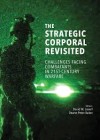The Strategic Corporal Revisited: Challenges Facing Combatants in 21st Century Warfare
Eds: David W Lovell and Deane-Peter Baker
UCT Press, 2017,
ISBN 9781775822202, 210pp
Reviewed by Diana Clark Gill
Edited books command a reader’s attention differently from single-author volumes. The former are beehives of perspectives, while the latter enjoy the force of a single mind. For this book, though, I endorse the editors’ choice of the group approach due to the complexity of the subject. The book’s contributors, several of whom are former soldiers, include professors of ethics, international law and international relations.
The phrase ‘strategic corporal’ was coined in 1999 by US Marine General Charles Krulak in a Marine Corps magazine. The label captures how low-level squad leaders, while on a mission, can be simultaneously confronted with multiple tasks (combat, peacekeeping operations and humanitarian aid) within a very small area—the colloquial ‘three-block war’.
Lovell and Baker divide the book’s focus into two halves. The first deals with how modern warfare increasingly requires non-commissioned officers (NCOs) with superior ‘strategic skills’. The second focuses on how the training of such soldiers should be conducted. Outside these practicalities, though, the book is also what contributor Anthony Moffitt terms ‘a call to action for an outdated military paradigm’.
Editor David Lovell explains how NCOs have risen in importance due to reductions in manpower in military areas of operation. Today’s lower-level officers, leading small groups of soldiers, may ‘have a level of autonomy to carry out the mission that those who breasted the trenches on the Western Front during the First World War could not even conceive’.
Contributor Nick Jans states that Australia, in particular, stands out amongst its allies for the efficacy of its ‘small-group operations’ and that:
[Anzac ‘junior leaders’ have proven their ‘three-block’ proficiency] in a range of operational areas over the past few decades (Somalia, East Timor, Iraq and Afghanistan), contributing significantly to the success of Australian operations, while at the same time avoiding the damaging operational and ethical scandals experienced by Canadian, Italian, Belgian and American allies.
But even these successes, Jans points out, are marred by later findings that training for such eventualities had been primarily informal; his implication being that any successes could only be credited to the soldiers’ quick-wittedness as opposed to Australian Defence Force structured training.
The Strategic Corporal Revisited voices the consensus that, while global military conflict has changed, the training of Western soldiers has not, especially in regard to ‘small-group operations’. David Lovell stresses that this is a time for senior officers ‘to listen to their juniors’. These young officers, leading missions with six to eight soldiers, regularly encounter rapidly shifting threats not on traditional battlefields but in congested urban centers, and their combat has been skewed into asymmetrical skirmishes against small groups of insurgents dressed as civilians and operating high-tech weaponry. As Krulak warned, the ‘lines separating the levels of war, and distinguishing combatant from non-combatant, will blur’.
It is vital then that, to protect members of the local population from their own section weapons and carry out the mission, an NCO must lead as a general, showing the section a steadfast calm along with a ‘familiarity with legal and ethical issues, and an ability … to understand local culture and communicate with those in villages and neighbourhoods whose goodwill, or at least neutrality, are vital to ultimate success’.
As to how to create such NCOs, contributor David Lovell stops short of advocating that soldier-scholars become the norm, but he does support the principle that even the lowest officer should be given an ‘advanced study of history, of politics, of law and of literature [that] are essential to the modern soldier … [Basically] I am commending the ability to process the vast amounts of information with which we are confronted to create knowledge; ordered and connected information’.
In assessing this book, I was struck by its surprising density of information. Unfortunately, not all of it was devoted to the ‘strategic corporal’. Too often, that label was brought in at the end of an essay by way of justifying the chapter’s inclusion in the book. One contributor even confessed that the subject was a ‘non-issue’ in his chapter. This criticism aside, The Strategic Corporal Revisited has much to recommend it—mainly its positive attitude about updating the military to respond to the needs of the 21st century soldier. Lovell reminds us that to choose the armed services is to choose ‘a career open to talents’. Contributor Anthony Moffitt elaborates, ‘Given opportunities to be creative, innovative, to act and think independently and autonomously, given responsibility our soldiers will spring to life; they will astonish you’.

